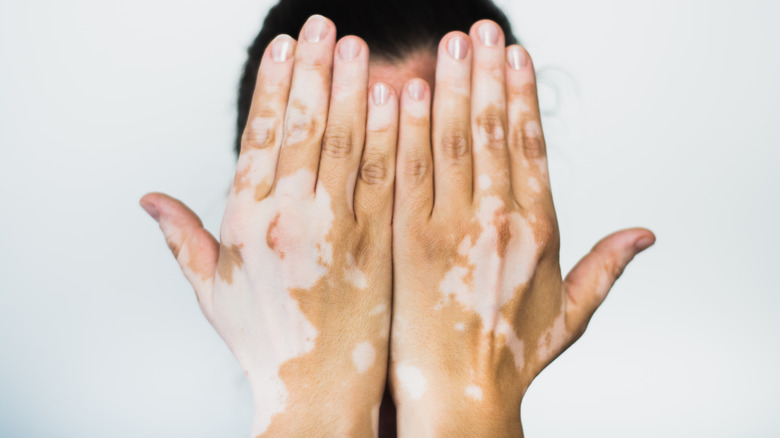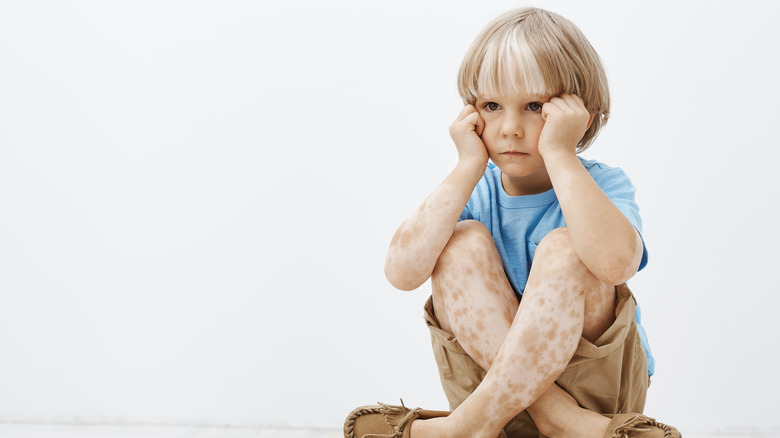Winnie Harlow's Skin Condition Explained
In the past, female runway models were famously known for being physically flawless and flat-out unattainable at times. But recently, the fashion industry is promoting some much-needed diversity in the women they choose to represent campaigns or model fashion lines. One of these models who is shaking up the fashion industry is Winnie Harlow.
Although Winnie's physical physique is still incredible, she's not the stereotypical model type because of her skin condition called vitiligo. As a child, Winnie Harlow was the target of relentless bullying due to her skin condition and eventually dropped out of public school to be home-schooled so she could avoid the torment of her classmates (via CNN). Her perseverance through those difficult years of her life has certainly paid off now. Winnie Harlow has a large following on social media and is helping bring awareness to her condition as well as expanding the standards of beauty in the modeling world.
What is vitiligo?
Vitiligo is a cosmetic skin condition that causes the skin to lose its pigment in different places on the body. This happens when melanocytes are destroyed by the body's immune system. Melanocytes are the skin cells that produce melanin and give the skin its natural color (via Cleveland Clinic). Without these cells, people with vitiligo often have white patches on their skin due to the lack of melanin in those places.
People that are diagnosed with vitiligo often start to see skin color loss on their hands, face, and genitals first, but vitiligo can appear on any part of the body, including your hair. Depending on the specific type of vitiligo that someone has, different parts of the body may be affected by the loss of skin color. In some cases, people only see white patches on their faces and hands, which is known as acrofacial vitiligo. Vitiligo can also affect any age group, but it's often diagnosed before the age of 30 (via Mayo Clinic).
How do you get vitiligo?
Despite some people's initial reaction to vitiligo, doctors know that vitiligo is not contagious (via American Academy of Dermatology). It's still unclear exactly what causes the melanin-producing cells to die, but it may be related to family history, your immune system, or a stressful event (via Mayo Clinic). All of these explanations of the possible causes of vitiligo are theories, not scientific facts. Despite doctors understanding the mechanics of vitiligo, there's still a lot they don't understand about the human body and why certain things happen.
None of the theories that doctors and researchers have come up with fully explain why vitiligo presents itself in some people and not others, so it is thought that a combination of autoimmune deficiencies, genetics, and stress events could be responsible for causing vitiligo (via Cleveland Clinic). This skin condition is most often diagnosed after people start noticing white patches on their skin where there is no longer any pigment.
What are the signs and symptoms of vitiligo?
The first signs of vitiligo are often a small pale spot on the skin that is lighter than the rest of the body. Over time, these spots grow larger until they are the large white patches that we described earlier. Depending on the specific type of vitiligo that a person has, these patches may cover large parts of the body or be limited to specific areas. The white spots that appear also may never become patches. Vitiligo affects everyone differently, so the degree to which the skin loses its pigment will be different for each person.
Although developing vitiligo can be a stressful time in someone's life, the good news is that it is not a painful skin condition to have. It might seem like the process of losing pigment in your skin would be uncomfortable, but people who have vitiligo report that it doesn't cause any discomfort, dryness, or irritation (via Medical News Today).
How is your life different if you have vitiligo?
Vitiligo is most commonly classified as a cosmetic skin condition, meaning that it doesn't have much effect on the overall health of someone who has it, but that doesn't mean that it won't have any effect on your life at all. Like Winnie Harlow, many people who are diagnosed with vitiligo suffer some degree of teasing or bullying. It can be especially hard for children and young adults who develop vitiligo to have normal social experiences because of the social stigma surrounding vitiligo, and their self-esteem could suffer as a consequence (via Medical News Today).
In addition to the anxiety of having a skin condition, people with vitiligo also have to be extra cautious with their skin because the parts of the skin that lack melanin are more sensitive to things like the sun. The white patches from vitiligo are much more likely to become sunburnt, so it's even more important for people who have vitiligo to apply sunscreen generously (via Cleveland Clinic).
Is vitiligo curable?
Vitiligo is not curable since we don't know exactly what causes it to present itself. Most people that are diagnosed with vitiligo will have it for the rest of their lives. However, there are several treatment options to help deal with the effects of vitiligo. Phototherapy with a UV lamp is a common treatment for vitiligo because it can sometimes help repigment the skin that has lost melanin (via Medical News Today).
Many people also opt for a camouflage technique, which includes wearing sunscreen to minimize the contrast between the normally pigmented skin and the white patches, or wearing makeup to cover the white spots from view (via Cleveland Clinic). More aggressive treatment options include tattooing the skin to match the normally pigmented skin or getting a skin graft via surgery. It can be difficult to come to terms with vitiligo, so many doctors also recommend some form of therapy to work through anxiety and self-confidence problems that you may be having due to the change in your appearance.
Being diagnosed with vitiligo can be life-altering news, but if Winnie Harlow has shown us anything, it's that beauty isn't one thing, and people that look different can still be beautiful.






